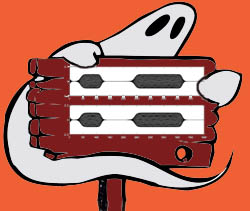
Other reports followed, including a former assistant manager at the Information Center above the cellar, who felt an intense presence in the cellar to the extent that she would talk to it.
Two witches investigated and declared the cellar to be haunted but by a friendly ghost; a third witch investigated alone and was less charitably received.
I discussed the events with Bill Dunn, a colleague in our School of Engineering who was aware of my work. He offered his services and a spectrum analyzer to do measurements.
Infrasound In The Cellar
The hypothesis was that we would find infrasound in the cellar. I did not suggest to him that 19 Hz would be implicated at this stage. However, Dunn did find a 19 Hz signal, which we discovered peaked in amplitude at the door, the point where most of the witnesses report a feeling of presence.
The dimensions of the medieval cellar would not support resonance at 19 Hz, but the modern corridor attached to it could.
In fact, this fits with the witnesses’ comments because they did not always enter the cellar itself. I believe they experience the infrasound effects in the corridor approaching the cellar, rather than the cellar itself.
At the cellar door, these feelings peak and, if a supernatural cause is considered, the blame is usually placed on the cellar because of its spooky appearance. This would lead me to suggest that these particular apparitions are a combination of infrasound and spookiness.
So: Infrasound + Spookiness = Apparition
The apparition only appeared in the lab when the person seeing it was alone and either early in the morning or at night when the light outside was dim. With colleagues around, the feeling of security is increased and an apparition is less likely to be perceived.
The level of signal in the cellar is low but the ambient noise level down there is also extremely low. We don’t know if the signal’s level is constant or if it is higher during the apparitional experiences.
The mechanism for the effect on humans is not completely clear. However, there seems little doubt that infrasound can affect humans in ways which are dependent on the environment and the individual’s sensitivity. It would be useful to test these more subtle effects in a controlled environment without too many harmonics.
Standing Waves
Most audio professionals are familiar with urban night clubs, where standing waves are a common problem.
Resulting from symmetrically shaped, usually rectangular rooms, these standing waves are a predictable challenge to usable gain-before-feedback. Many a graphic equalizer has failed to filter a 350 Hz howl from a downtown bar.
Where musical, especially stringed, instruments are concerned, standing waves are also a major component of desirable harmonic content. In addition, harmonic content, as we know, plays a major role in nearly everyone’s psychoacoustic response.
It’s all about vibrations. Often, these are “Good Vibrations” where the psychoacoustic energy is all good. Other times, however, harmonic vibrations can manifest foreboding moods and an emotional sense of dread.
In terms of wave propagation, standing waves are naturally formed by the interference of two harmonic waves of identical frequency and amplitude (and therefore same wavelength), traveling in opposite directions.
One characteristic of every standing wave pattern is that there are points, which appear to be standing still. These points, sometimes referenced as points of no displacement, are commonly called as nodes.
There are other points along the atmospheric medium which undergo vibrations between large positive and large negative displacements. These points undergo the maximum displacement during each vibrational cycle of the standing wave.
Functionally, these points are the opposite of nodes, and hence called anti-nodes.
Vic Tandy teaches at the School of International Studies and Law at Coventry University in the UK.
